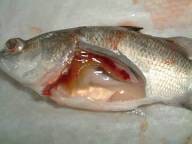Often mortality over a typical production cycle ranges between 20-80 per cent. Due to a general lack of diagnostic capacity, epidemiological data with respect to the origin of this mortality is usually poorly documented. Therefore, there was a need to identify the most common and economically important diseases in the region. Intervet Norbio Singapore has been conducting epidemiological investigations in the region in both the marine and freshwater environments over the past 7 years. The focus of this article will be on disease cases of bacterial origin.
We have found that diseases such as streptococcosis due to Streptococcus iniae and S. agalactiae, nocardiosis due to Nocardia seriolae, and infections with Tenacibaculum maritimum and Flavobacterium columnare are common bacterial infections that affect a wide range of cultured fish species in South East Asia. The table below illustrates the number of isolates, countries investigated and fish species from which the pathogens were isolated. Our investigations and reports from the literature suggest that these diseases are becoming increasingly important as a consequence of the intensification of aquaculture. Photographs of typical disease signs as well as a description of the pathogen involved is given for the major pathogens found in the marine (Figures A-G) and in freshwater environments.
| Bacterial Species | Number of isolates recovered | Number of different locations sampled | Fish species susceptible for all 3 pathogens | Other species affected | Countries of sampling |
|---|---|---|---|---|---|
| Marine environment | |||||
| Steptococcus iniae | 213 | 30 | Pompano, Snappers, Yellow croaker, Groupers, Yellowtail, Amberjack, Flounder | Asian sea bass, Threadfin, Sea bream | Malaysia, Singapore, Indonesia, Thailand, Philippines, China, Vietnam, Japan, Korea, Taiwan, Australia |
| Norcardia seriolae | 40 | 10 | Threadfin, Trevally Striped sea bass | ||
| Tenacibaculum maritimum | 77 | 22 | Asain sea bass, Sea bream, Red drum, Turbot | ||
| Fresh water environment | |||||
| Steptococcus agalactiae | 219 | 22 | Tilapia | Catfish | Indonesia, Malaysia, Singapore, Thailand, Philippines, China, Vietnam |
| S. iniae | 75 | 14 | Goby, Puntius | ||
| Flavobacterium columnare | 40 | 16 | Japanese & European eel | ||
In addition to these more established pathogens, we have recently identified upcoming bacterial diseases potentially harmful for aquaculture species. Infections with bacterial pathogens such as Edwardsiella tarda and Streptococcus dysgalactiae are emerging in several countries. Moreover, a previously unrecognized disease named Pot Belly or Big Belly disease caused by a facultative intracellular Gram-negative bacterium was identified. Infections with this previously uncharacterized pathogen causes severe visceral granulomatous lesions in Asian sea bass fry < 5 g with an associated mortality rate that can be in excess of 70-80 per cent. Finally, a second granulomatous disease in Tilapia sp. due to a Francisella-like organism causing up to 50 per cent mortality was identified as an emerging disease in the region.
The table below summarizes the fish species and isolates recovered.
| Pathogen | Number of total isolates recovered | Number of different locations sampled | Fish species susceptible | Countries |
|---|---|---|---|---|
| E. tarda | 24 | 7 | Red sea bream, Japanese Flounder, Turbo, Eel, Catfish | Japan, China, Korea |
| S.dysgalactiae | 14 | 7 | Yellowtail, Pompano | Japan, China |
| Big Belly disease | 10 | 3 | Asian sea bass | Singapore, Malaysia, Indonesia |
| Francisellasp | 6 | 1 | Tilapia | Indonesia |
Gross and histological signs of pathogens isolated from the Freshwater environment
 |
 |
| Strep. iniae infection in Asian sea bass | Red snapper showing typical clinical signs of nocardial infections: ascites, splenomegaly, macroscopic nodules in spleen (arrow). |
Intervet Singapore hope to continue monitoring for common and emerging aquatic animal disease in the South East Asia region and will keep cutomers informed of their results.
October 2007




